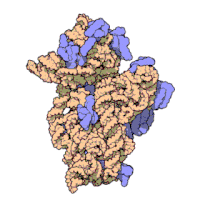
Photo from wikipedia
Anammox bacteria are widely distributed and contribute significantly in the global nitrogen cycle. Traditionally, identification and quantification based on 16S rRNA gene were considered not reliable because of low 16S… Click to show full abstract
Anammox bacteria are widely distributed and contribute significantly in the global nitrogen cycle. Traditionally, identification and quantification based on 16S rRNA gene were considered not reliable because of low 16S rRNA gene sequence identity within Brocadiales. Here we hypothesize that by using appropriate primers and methodology, 16S-based detection and quantification of anammox bacteria can be accurate. We modified an existing 16S rRNA gene-based primer pair (Amx694F-Amx960R) by changing one nucleotide (Amx694F position 18, G→C) (Amx694PF-Amx960R) so that they match the sequences of most Brocadiales anammox bacteria, and evaluated the modified primer pair with 29 freshwater samples from microcosms, anammox reactors and wastewater treatment plants of various geographical origins. The primer pair showed high specificity in detection and quantification of anammox populations in samples that contained > 0.1% anammox bacteria. Quantification of anammox abundance by quantitative real-time PCR and delineation of anammox species by denaturing gradient gel electrophoresis agreed well with amplicon sequencing results. A clear shift of anammox population towards 'Candidatus Kuenenia' was observed under laboratory cultivation conditions. With the help of amplicon sequencing, we demonstrated that 16S rRNA gene-based anammox-specific primers are able to achieve qualitative and quantitative monitoring of anammox communities in wastewater treatment plants and natural freshwater environments.
Journal Title: FEMS microbiology ecology
Year Published: 2020
Link to full text (if available)
Share on Social Media: Sign Up to like & get
recommendations!